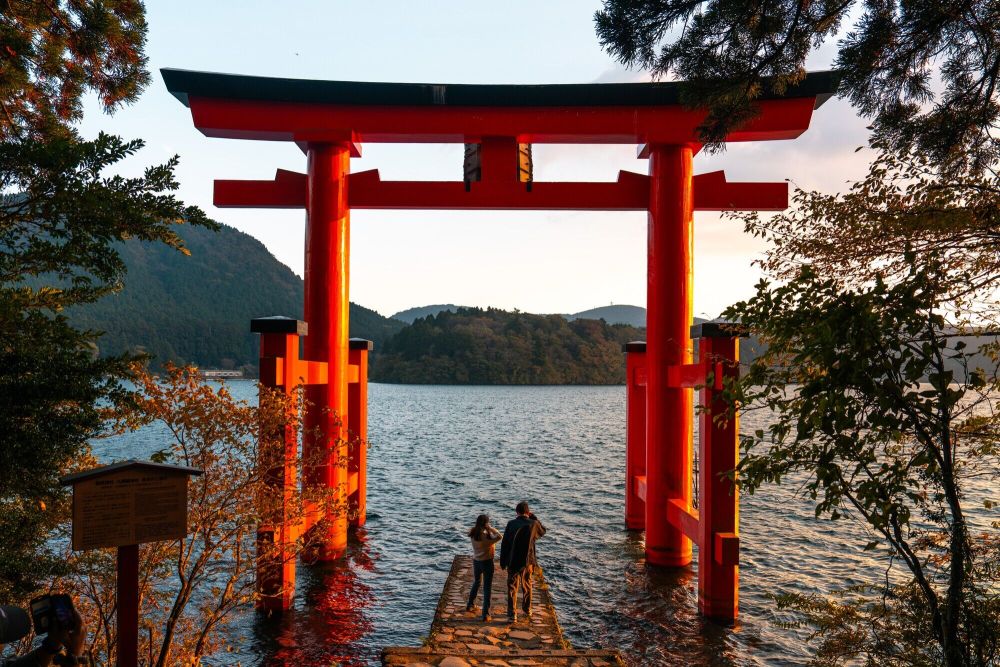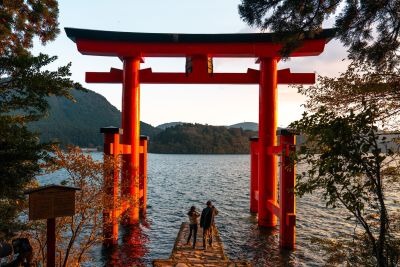

The Hakone Open-Air Museum, also known as the Hakone Chokoku no Mori Bijutsukan, is Japan's first open-air museum, opened in 1969, blending masterful artwork with the natural beauty of Hakone. Spanning approximately 70,000 square meters, the museum's verdant grounds are home to a rotating collection of over 100 sculptures by renowned artists, offering a unique harmony between art, architecture, and nature. Visitors can stroll through the scenic grounds and admire works by famous sculptors like Henry Moore and Auguste Rodin. The museum also houses a sizable Picasso Pavilion featuring a comprehensive collection of the artist's work, including sculptures, ceramics, and paintings. Indoor galleries and interactive exhibits make it a place of creativity and inspiration for all ages. Additionally, it offers hot spring footbaths, allowing visitors to soak their feet while gazing at the surrounding mountains.
Nestled along the shores of Lake Ashi, at the foot of Mount Hakone, the Hakone Shrine is a serene and historic Shinto shrine known for its tranquility and spiritual significance. It dates back over 1,200 years and has a storied history connected with prominent samurai and feudal lords. An iconic feature of the shrine is the large torii gate that stands in Lake Ashi, creating a surreal gateway as it appears to float on the water, offering a picturesque backdrop for visitors and worshipers. The environment of the shrine is both mystical and peaceful, with towering cedar trees surrounding the grounds, adding to the sense of sacredness. Devotees and tourists alike are drawn to the shrine for its cultural heritage, its stunning location, and the belief in its powers to bring good fortune. It is a place of pilgrimage during New Year's and festivals, and its serene atmosphere provides a calm retreat from the bustle of everyday life.
Owakudani, known as the 'Great Boiling Valley', is a volcanic valley with active sulfur vents and hot springs located in Hakone, part of the Fuji-Hakone-Izu National Park. Created about 3,000 years ago following the eruption of Mount Hakone, the valley offers breathtaking views of Mount Fuji on clear days. Tourists can visit various steam vents and bubbling pools, witnessing the raw power of nature. One of the local delicacies that must not be missed is the kuro-tamago, or black egg, which is an egg hard-boiled in the valley's sulfuric hot springs, said to prolong one’s life by seven years. Owakudani also serves as a starting point for hikes to Mount Kamiyama and Mount Komagatake. While exploring the valley, visitors should be mindful of occasional increases in volcanic activity that can limit access to certain areas for safety reasons.
Lake Ashi, also referred to as Ashinoko, is a picturesque crater lake in the Hakone region, known for its stunning views of Mount Fuji and its serene, natural beauty. A cruise on Lake Ashi is a must-do activity for any visitor. These cruises often employ ships that are styled after 17th-century pirate ships, adding a whimsical charm to the experience. While onboard, passengers can enjoy panoramic views of the surrounding mountains, the floating Hakone Shrine torii gate, and on a clear day, the majestic Mount Fuji. The cruise offers a relaxing way to take in the sights and is particularly popular during autumn when the surrounding foliage changes into vibrant hues of red, orange, and yellow, creating an enchanting setting. Options vary from short jaunts to longer explorations that include stopping at various points along the lake's shore.
The Hakone Tozan Railway is Japan's oldest mountain railway, known for its picturesque journey through the lush valleys and steep mountainsides of the Hakone region. This train ride is especially popular during the hydrangea season when the flowers bloom alongside the tracks in vibrant blues and purples. Starting from Odawara, the train winds its way through small stations, each offering unique attractions, before reaching the final stop at Gora. The train journey itself is an enchanting experience, featuring switchbacks, where the driver and conductor swap positions, allowing the train to ascend the steep terrain. The scenic ride provides breathtaking vistas of the Hakone mountains, valleys, and the opportunity to immerse in the area's natural beauty. Many travelers enjoy this unique railway experience as a prelude to exploring other attractions, including open-air museums and hot spring resorts.
The Hakone Ropeway offers a thrilling aerial journey across the spectacular landscapes of Hakone National Park. Spanning over 4 kilometers, the ropeway connects Sounzan Station to Togendai Station, providing breathtaking views of the surrounding mountains, Lake Ashi, and the volcanic Owakudani Valley. Each gondola can accommodate up to 18 passengers, ensuring that every traveler has a chance to enjoy the panoramic sights. On a clear day, Mt. Fuji's snow-capped peak can be seen in the distance, creating postcard-perfect scenery. The ropeway is also an ideal way to access various tourist destinations, including hot springs and the Hakone Open-Air Museum. While the ride is relatively short, it offers a unique perspective of Hakone's diverse terrain, making it a memorable part of any trip to the area.
